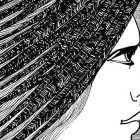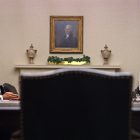On the Trail of L. Frank Baum
Many people’s notions of Kansas, my home state—which once issued license plates that said “Land of Ahs”— come straight from The Wizard of Oz. A pen-pal from Ohio once told me that she envisioned Kansas as a beautiful, colorful place bisected by roads made of pure gold. I had to gently explain, with all the twelve-year-old tact I could muster, that she was confusing us with Oz, that we were the black-and-white segments, and that no, in actuality Kansas was not a black-and-white state.
I never read The Wizard of Oz, but it also turns out that author L. Frank Baum never actually lived in Kansas, either. Nor was the movie that was broadcast annually made in Kansas—it was filmed on an MGM studio lot.
But while books like those in Laura Ingalls Wilder’s Little House series more overtly shaped my ideas of the Great Plains and the pioneering spirit of my ancestors, The Wizard of Oz subtly infiltrated my conceptions of my home state, with its farms and tornadoes and homespun people.
The Wizard of Oz, published in 1900, changed the course of children’s literature, with its focus on celebrating imagination instead of imparting moral lessons. More recently, working on a book about imaginative heroines in children’s literature, I realized I owed some measure of gratitude to Baum, who undoubtedly influenced some of the books of my childhood and thus, in a roundabout way, the values they passed on to me. The books I loved had smart, spunky, creative female characters with rich inner lives, and I wanted to be like them.
So basically, a book I never read by a guy who never lived in my home state and a movie about Kansas that wasn’t filmed in Kansas affected me more profoundly than I ever realized.
Now I live in Bradford, PA, an old western PA oil town, where, it has long been rumored, Baum once lived.
Tim Ziaukas recently published an article about this in Western Pennsylvania History, squealching those rumors, which appear to have been based on a mistake that got blown out of proportion. But, Tim explains, Baum’s father had made his fortune in area oil fields in the late 1800s, enabling the life that made Baum a writer. (No wonder the Tin Man looks like a big oil can.)
So here I am again, living in another place where Baum never lived but where his spectre nevertheless remains. And sometimes inadvertently, sometimes on purpose, I often find myself on Baum’s trail.
Like in South Dakota on a tour of Laura Ingalls Wilder sites, when I discovered that he had worked as a newspaper reporter nearby during some of the same years.
Or visiting Coronado Island in San Diego, when I learned that Baum had not only written there, but had also announced plans to buy an island that doesn’t actually seem to have existed off the coast of California; there he intended to open an amusement park called the “Marvelous Land of Oz,” “a fairy paradise for children,” fifty years before Walt Disney opened Disneyland.
Or passing through Wamego, Kansas, when I took a quick spin through the Oz Museum, which displays troll dolls of the characters; hand-jeweled ruby slipper replicas; and life-sized tableaus with white picket fences, flowers, rolling hills hoed into rows, and fluffy clouds in the distance—a sunny and idyllic Kansas scene.
Later, headed to Concord, MA, and Louisa-May-Alcott territory, we passed through Chittenango, NY, Baum’s birthplace. Sadly, the “Everything About Oz,” museum had closed a few years before, though you can still walk the yellow brick path through the downtown Chittenango sidewalks.
Even at the JELL-O Gallery Museum in LeRoy, NY, there was Baum. In 1933, the Tin Man and Scarecrow were spokespersons-of-sorts for JELL-O. “Surely a wizard invented JELL-O [gelatin] desserts!” they are pictured saying. “They’re so wonderful they sound like magic! And the lovely JELL-O [gelatin] colors must have come from a fairy’s jewel box, we’re sure.”
Outside, though, the JELL-O brick road proved to be a bit of a disappointment–just bricks carved with donors names. I’d been hoping for bricks made of JELL-O, maybe even an entire JELL-O Wizard of Oz tableau.
The first message I absorbed from The Wizard of Oz is that there’s no place like home, and growing up, I fully expected to stay put my whole life, to value permanence and stability above all else. But the real message, the kind that led me to instead move twelve times in eighteen years, looking for a life that would center on books and writing, is that home without imagination is bleak and spare, black and white. Imagination is what fills life in with color and takes us to extraordinary places.
Unlike Dorothy, I have strayed far from my own backyard—but, I discovered, so did Baum.





